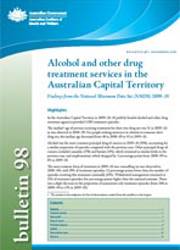Summary
In the Australian Capital Territory in 2009–10, 10 publicly funded alcohol and other drug treatment agencies provided 3,585 treatment episodes. The median1 age of persons receiving treatment for their own drug use was 31 in 2009–10, as was observed in 2008–09. For people seeking assistance in relation to someone else’s drug use, the median age decreased from 48 in 2008–09 to 43 in 2009–10.
Alcohol was the most common principal drug of concern in 2009–10 (55%), accounting for a similar proportion of episodes compared with the previous year. Other principal drugs of concern included cannabis (17%) and heroin (14%), which remained at similar levels to the previous year, and amphetamines which dropped by 3 percentage points from 2008–09 to 6% in 2009–10.
The most common form of treatment in 2009–10 was counselling (as was observed in 2008–09), with 30% of treatment episodes; 12 percentage points lower than the number of episodes receiving this treatment nationally (42%). Withdrawal management remained at 21% of treatment episodes; five percentage points higher than the national estimate. There was a slight decrease in the proportion of assessment only treatment episodes (from 16% in 2008–09 to 13% in 2009–10).
1. The median is the midpoint of a list of observations ranked from the smallest to the largest.
Highlights
Treatment agencies
Client profile
Drugs of concern
Treatment programs
Symbols
How to find out more
End matter: Reference



